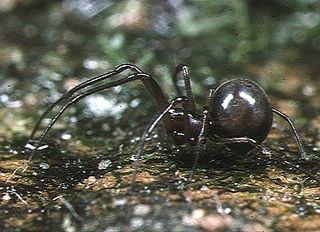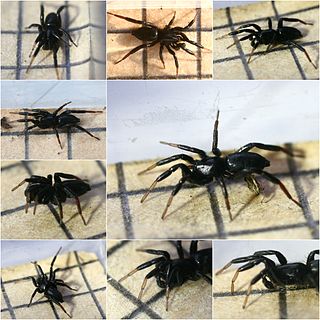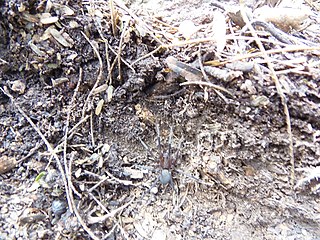
Lampshade spiders, family Hypochilidae, are among the most primitive of araneomorph spiders. There are two genera and twelve species currently recognized. Like mygalomorphs, most hypochilids have two pairs of book lungs, but like araneomorphs they have intersecting fangs, with the exception of some species which have chelicerae in an angle that is neither orthognathous or labidognathous. These long-legged spiders build typical "lampshade" style webs under overhangs and in caves. In the United States the fauna is primarily associated with the Appalachian, Rocky and California Mountains. Ten of the known species are found in these ranges, all in the genus Hypochilus. The genus Ectatosticta is found in China.

Leptonetidae is a family of small spiders adapted to live in dark and moist places such as caves. The family is relatively primitive having diverged around the Middle Jurassic period. They were first described by Eugène Simon in 1890.

Dwarf tarantulas, also known as sheet funnel-web spiders are a type of spider from the family Mecicobothriidae. Dwarf tarantulas are one of several families of the suborder Mygalomorphae; this larger group also includes the true tarantulas.

Norman Ira Platnick was an American biological systematist and arachnologist. At the time of his death, he was a professor emeritus of the Richard Gilder Graduate School and Peter J. Solomon Family Curator Emeritus of the invertebrate zoology department of the American Museum of Natural History. A 1973 Ph.D. recipient at Harvard University, Platnick described over 1,800 species of spiders from around the world, making him the second most prolific spider taxonomist in history, behind only Eugène Simon. Until 2014 he was also the maintainer of the World Spider Catalog, a website formerly hosted by the AMNH which tracks the arachnology literature, and attempts to maintain a comprehensive list, sorted taxonomically, of every species of spider which has been formally described. In 2007 he received the International Society of Arachnology's Bonnet award, named for Pierre Bonnet, in recognition of his work on the catalog.

Anapidae is a family of rather small spiders with 232 described species in 58 genera. It includes the former family Micropholcommatidae as the subfamily Micropholcommatinae, and the former family Holarchaeidae. Most species are less than 2 millimetres (0.079 in) long.

Sphodros is a genus of North American purseweb spiders first described by Charles Athanase Walckenaer in 1835. It was considered a synonym of Atypus until 1980.

Coneweb spiders (Diguetidae) are six-eyed haplogyne spiders that live in tangled space webs, fashioning a cone-like central retreat where they hide and lay eggs. It is a small family, containing only two genera with fifteen species and is confined to the New World, preferring deserts. Members of the genus Diguetia usually build their webs in shrubs or between cactus pads. They have the same eye arrangement as the venomous recluse spiders, but none are known to be harmful to humans.
Hexurella pinea is a species of spider native to the United States. It was first described by Gertsch and Platnick in 1979. It is from the family Hexurellidae.
Hexurella rupicola is a species of spider native to the United States. It was first described by Gertsch and Platnick in 1979. It is from the family Hexurellidae.
Hexurella encina is a species of spiders native to Mexico. It was first described by Gertsch and Platnick in 1979. It is from the family Hexurellidae.
Hexurella is a genus of spiders, found in the United States and Mexico. It is the only genus in the family Hexurellidae.

Micaria is a genus of ground spiders that was first described by Niklas Westring in 1851. They are 1.3 to 6.5 millimetres long.
Anapisona is a genus of araneomorph spiders in the family Anapidae, first described by Willis J. Gertsch in 1941.
Austrochilus is a genus of South American cribellate araneomorph spiders in the family Austrochilidae, first described by H. Zapfe in 1955.
Ozarkia is a genus of North American leptonetids that was first described by J. Ledford in 2011.
Noonops is a genus of spiders in the family Oonopidae. It was first described in 2013 by Platnick & Berniker. As of 2017, it contains 23 species from the U.S., Mexico, and the Bahamas.

Drassyllus is a genus of ground spiders that was first described by R. V. Chamberlin in 1922.

Zorocrates is a genus of spiders in the family Zoropsidae. It was first described in 1888 by Simon. As of 2017, it contains 31 species.









